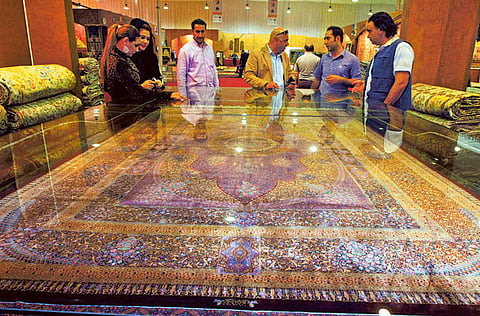Fancy a Dh22m handwoven Persian carpet?
Three Iranian weavers toiled for 14 years to complete the artefact

Dubai: After meticulously weaving 44 million individual knots by hand, three Iranian weavers finally completed a Persian carpet worth $6 million (Dh22 million), which is on display at Dubai Shopping Festival’s (DSF) Carpet and Art Oasis.
The Persian carpet, which took 14 years to complete, was exhibited by Azimzadeh Carpet, a family business based in Iran, which was established in 1956.
“The weavers had to wear special magnifying glasses to make the individual tiny knots of the two-by-three metre carpet,” Saleh Eghbali, the sales manager of Azimzadeh Carpet, said.
Eghbali said that every seven metres of the carpet had 180 knots, adding that the number of knots per seven centimetres determines the price of the carpet. “The higher the number of knots, the higher the price,” he said.
“The great detail in addition to the pure silk and natural colouring used to make the carpet is what makes it so unique and expensive. It is a piece of rare art,” he said.
Carpet weaving, a dying craft
Like other Persian carpet dealers who spoke to Gulf News, Eghbali said that fewer people are learning the craft because it is a difficult one that requires a lot of patience and time.
Iranian Mahmoud Malakouti, whose family has been working in the Persian carpet industry for the past 90 years, said the younger generation is moving away from the craft because they are looking for easier methods to make money.
“Younger people are opting for university degrees where they only have to study for four years to start making money while carpet weaving involves working hard for one year [for a basic six-metre carpet] to make a single carpet. They are looking for an easier and faster way to make a living.”
UAE resident Mohammad Al Ghazali, who has been working in the industry for the past 45 years, said that although carpet weaving has been passed down by Iranian families for the past 2,000 years, the craft is losing popularity.
“From my experience, demand is still high. Every house in the Gulf still opts for Persian carpets, however the newer generation seems to be moving away from this craft that his been taught for thousands of years.”
Malakouti believes that one day, Persian carpets will be as rare as a Picasso painting and will be sold as pieces of art or hung in museums.
Sign up for the Daily Briefing
Get the latest news and updates straight to your inbox



